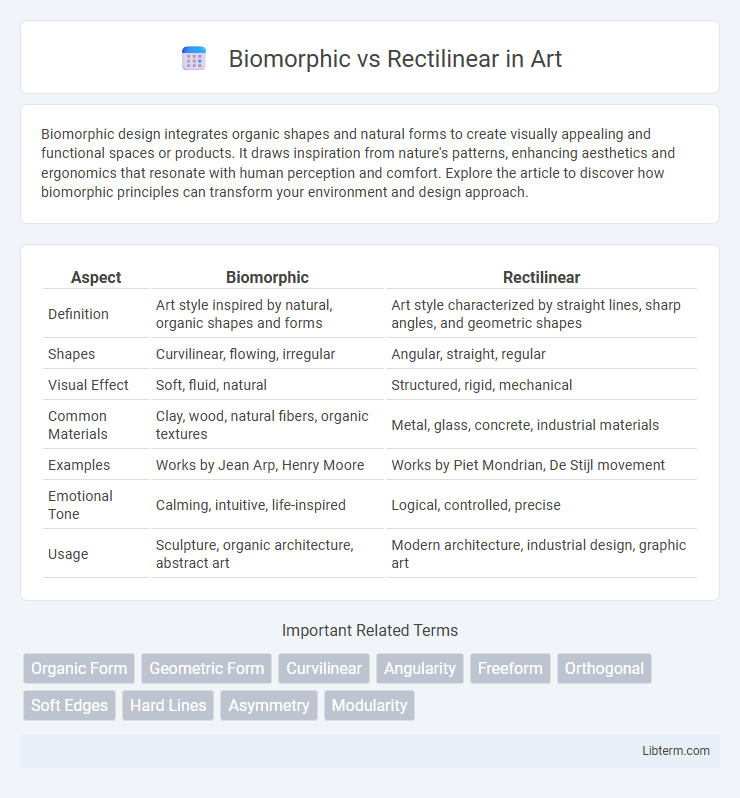Biomorphic design integrates organic shapes and natural forms to create visually appealing and functional spaces or products. It draws inspiration from nature's patterns, enhancing aesthetics and ergonomics that resonate with human perception and comfort. Explore the article to discover how biomorphic principles can transform your environment and design approach.
Table of Comparison
| Aspect | Biomorphic | Rectilinear |
|---|---|---|
| Definition | Art style inspired by natural, organic shapes and forms | Art style characterized by straight lines, sharp angles, and geometric shapes |
| Shapes | Curvilinear, flowing, irregular | Angular, straight, regular |
| Visual Effect | Soft, fluid, natural | Structured, rigid, mechanical |
| Common Materials | Clay, wood, natural fibers, organic textures | Metal, glass, concrete, industrial materials |
| Examples | Works by Jean Arp, Henry Moore | Works by Piet Mondrian, De Stijl movement |
| Emotional Tone | Calming, intuitive, life-inspired | Logical, controlled, precise |
| Usage | Sculpture, organic architecture, abstract art | Modern architecture, industrial design, graphic art |
Introduction to Biomorphic and Rectilinear Design
Biomorphic design features organic, flowing shapes inspired by natural forms, creating a sense of fluidity and softness in spaces and objects. Rectilinear design emphasizes straight lines and geometric shapes, producing a clean, structured, and modern aesthetic. Both styles influence architecture, furniture, and graphic design, offering distinct visual experiences through contrasting forms.
Defining Biomorphic Forms
Biomorphic forms are characterized by organic, curvilinear shapes inspired by nature, often resembling living organisms or natural patterns. These shapes contrast with rectilinear forms, which consist of straight lines and right angles, emphasizing geometric precision and structural clarity. Defining biomorphic forms involves recognizing their fluid, asymmetrical contours that evoke a sense of natural growth and movement.
Understanding Rectilinear Structures
Rectilinear structures are characterized by straight lines, right angles, and geometric shapes, reflecting a sense of order, symmetry, and predictability. These designs emphasize functionality and efficiency, often found in modernist architecture, urban planning, and industrial design where clarity and uniformity are paramount. Understanding rectilinear forms involves recognizing their impact on spatial organization, structural stability, and the psychological perception of space as orderly and controlled.
Historical Evolution of Biomorphic Styles
Biomorphic styles originated in the early 20th century as a response to rigid geometric forms, drawing inspiration from organic shapes found in nature such as plants, animals, and the human body, prominently featured in Art Nouveau and later in Surrealism. Influential artists like Jean Arp and Henry Moore advanced biomorphic design by emphasizing fluid, curvilinear forms that evoke natural growth and movement, contrasting with the strict rectilinear geometry dominant in Modernist architecture and design. The evolution of biomorphic styles reflects a continuous exploration of natural aesthetics in art and design, integrating biological and anatomical references to create dynamic, expressive forms throughout the 20th century.
Origins and Development of Rectilinear Designs
Rectilinear designs originate from early modernist movements such as Bauhaus and De Stijl, emphasizing clean lines, geometric shapes, and functionality. These designs developed as a reaction to ornate, decorative styles, promoting minimalism and efficiency in architecture and furniture design. The rectilinear aesthetic continues to influence contemporary design through its focus on simplicity, order, and structured forms.
Key Characteristics of Biomorphic Architecture
Biomorphic architecture features organic, fluid shapes inspired by natural forms, emphasizing curves and asymmetry that mimic living organisms. It prioritizes harmony with the environment through materials and designs that evoke natural growth patterns and biological structures. This style often incorporates irregular, non-linear geometry to create spaces that feel dynamic and alive, contrasting sharply with rectilinear architecture's emphasis on straight lines, right angles, and geometric order.
Core Elements of Rectilinear Architecture
Rectilinear architecture emphasizes core elements such as straight lines, right angles, and geometric shapes, creating a sense of order and structure. This design approach utilizes grid-based layouts, sharp edges, and a clear hierarchy to maximize functional space and clarity. Materials often include concrete, steel, and glass, enhancing the architectural form's precision and minimalist aesthetic.
Major Differences: Biomorphic vs Rectilinear
Biomorphic design features organic, flowing shapes inspired by natural forms, while rectilinear design emphasizes straight lines, sharp angles, and geometric precision. Biomorphic forms prioritize curves and asymmetry to create a soft, natural aesthetic, contrasting with the rigid, structured appearance of rectilinear shapes. The major difference lies in biomorphic's fluidity and unpredictability versus rectilinear's focus on order, simplicity, and architectural clarity.
Applications in Modern Architecture and Design
Biomorphic design in modern architecture emphasizes organic, fluid forms inspired by nature, enhancing spaces with dynamic, natural aesthetics often seen in eco-friendly buildings and innovative furniture. Rectilinear design prioritizes straight lines and right angles, resulting in functional, minimalist structures widely used in urban developments, office complexes, and contemporary interiors. Both styles influence architecture and design by addressing different spatial experiences and user interactions, balancing creativity with practicality.
Choosing Between Biomorphic and Rectilinear: Factors to Consider
Choosing between biomorphic and rectilinear designs hinges on factors such as spatial function, aesthetic goals, and user comfort. Biomorphic shapes, inspired by natural forms, promote organic flow and psychological relaxation, making them ideal for spaces aiming to evoke warmth and creativity. Rectilinear designs, characterized by straight lines and sharp angles, suit environments requiring structure and organization, enhancing clarity and efficiency in both residential and commercial settings.
Biomorphic Infographic

 libterm.com
libterm.com